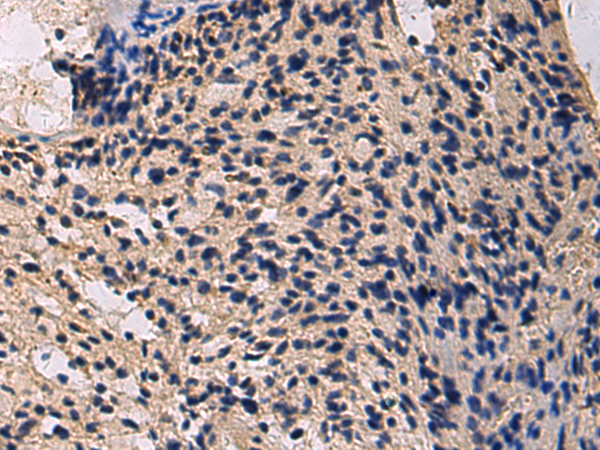

| WB | 咨询技术 | Human,Mouse,Rat |
| IF | 咨询技术 | Human,Mouse,Rat |
| IHC | 1/200-1/300 | Human,Mouse,Rat |
| ICC | 技术咨询 | Human,Mouse,Rat |
| FCM | 咨询技术 | Human,Mouse,Rat |
| Elisa | 1/5000-1/10000 | Human,Mouse,Rat |
| WB Predicted band size | 26 kDa |
| Host/Isotype | Rabbit IgG |
| Antibody Type | Primary antibody |
| Storage | Store at 4°C short term. Aliquot and store at -20°C long term. Avoid freeze/thaw cycles. |
| Species Reactivity | Human, Rat |
| Immunogen | Synthetic peptide of human GSTA5 |
| Formulation | Purified antibody in PBS with 0.05% sodium azide and 50% glycerol. |
+ +
以下是3篇涉及GSTA5抗体的代表性文献(信息已简化整理):
---
1. **文献名称**: *"Tissue-specific expression and subcellular localization of glutathione S-transferase A5 in mice"*
**作者**: Suzuki T, et al.
**摘要**: 通过Western blot和免疫组化分析,利用GSTA5特异性抗体揭示了该酶在小鼠肝脏和肾脏中的高表达,并定位在线粒体和细胞质中,提示其在器官特异性解毒功能中的作用。
---
2. **文献名称**: *"Downregulation of GSTA5 contributes to oxidative stress in human hepatocellular carcinoma"*
**作者**: Zhang Y, et al.
**摘要**: 使用GSTA5抗体检测肝癌组织样本,发现GSTA5蛋白表达显著低于癌旁组织,其低表达与ROS累积和化疗耐药相关,表明GSTA5可能作为肝癌治疗的潜在靶点。
---
3. **文献名称**: *"Developmental regulation of GSTA5 in murine embryonic tissues: insights from antibody-based profiling"*
**作者**: Thompson R, et al.
**摘要**: 通过免疫荧光和流式细胞术结合GSTA5抗体,发现该蛋白在胚胎发育早期(E12-E15)的小鼠肠道和神经系统中高表达,提示其在胚胎氧化应激防御中的关键作用。
---
**备注**:若需获取全文或更详细引用信息,建议通过PubMed或期刊数据库检索标题及作者。
The glutathione S-transferase alpha 5 (GSTA5) antibody is a tool used to detect and study the GSTA5 protein, a member of the glutathione S-transferase (GST) family. GSTs are phase II detoxification enzymes that catalyze the conjugation of glutathione (GSH) to electrophilic compounds, facilitating the elimination of toxins, carcinogens, and oxidative stress byproducts. The GSTA subclass, including GSTA5. is primarily expressed in the liver, kidneys, and other tissues involved in xenobiotic metabolism.
GSTA5 specifically plays a role in cellular defense against oxidative damage and chemical carcinogens. It is implicated in metabolic pathways regulating drug resistance, inflammation, and apoptosis. Research on GSTA5 has focused on its potential association with diseases such as cancer, neurodegenerative disorders, and liver pathologies, where oxidative stress or detoxification imbalances are prominent.
Antibodies against GSTA5 enable the investigation of its expression, localization, and function in biological samples through techniques like Western blotting, immunohistochemistry (IHC), and immunofluorescence (IF). These antibodies are critical for identifying GSTA5 as a biomarker in disease progression or therapeutic response. Studies using GSTA5 antibodies may also explore its interactions with other proteins or its regulatory mechanisms under stress conditions. As GST isoforms often exhibit tissue-specific expression and functional redundancy, GSTA5-specific antibodies help dissect its unique roles in cellular physiology and pathology.
×